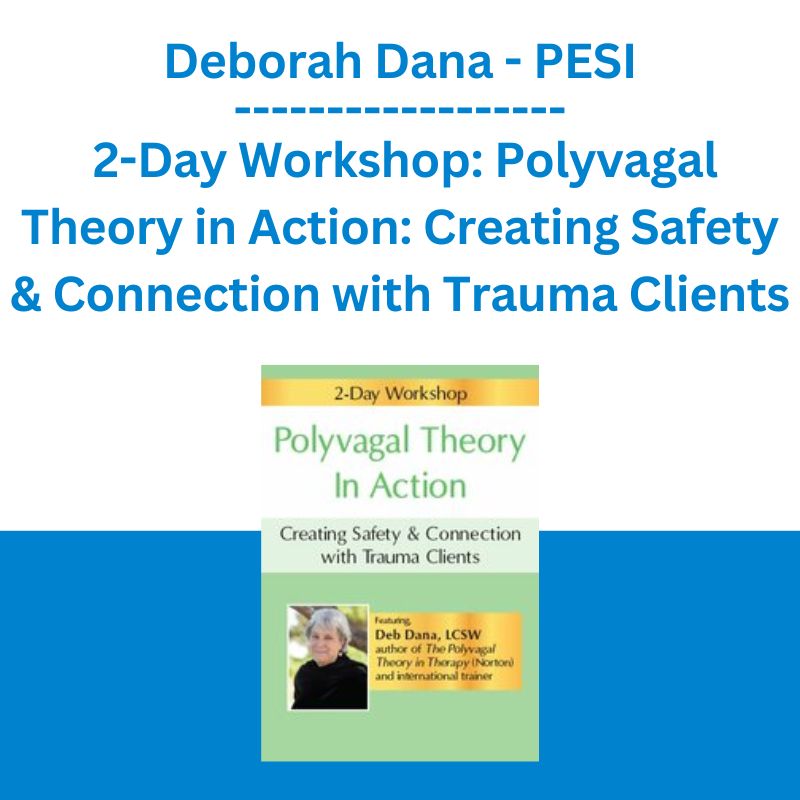*** Proof of Product ***
Exploring the Essential Features of “Deborah Dana – PESI – 2-Day Workshop: Polyvagal Theory in Action: Creating Safety & Connection with Trauma Clients”
2-Day Workshop: Polyvagal Theory in Action: Creating Safety & Connection with Trauma Clients
Speaker: Deborah Dana, LCSW, LICSW
Duration: 12 Hours 40 Minutes
Format: Audio and Video
Media Type: Digital Seminar
Description
Have you had a client who could out-think their trauma? Likely you haven’t… because trauma isn’t healed through thought.
Clients come to us looking for ways to feel safe and regulated in their daily lives – but the trauma client is often stuck in a dysregulated state.
Like us, they want to be able to navigate the normal “shifting” we do in our daily life – transitioning from one state to another. Hyper to calm, irritated to relaxed, overwhelmed to feeling in control.
In the words of author of The Polyvagal Theory in Therapy (Norton) and international trainer Deb Dana, LCSW, they are “longing to come into a state of regulation”.
And it’s our job to help them. It’s what we trained for, what we dreamed of doing, and where we get the deep satisfaction from the work we do.
By watching this two-day applied training, Deb will give you:
- A deep knowledge of Polyvagal Theory – in easy to understand language
- Practical ways to work with the autonomic nervous system that create connection and safety…through techniques she’s honed and will share with you
The Polyvagal approach is not a model of therapy or a protocol to follow. It is an understanding of three organizing principles around which you can create your own approach and technique, blending them with your preferred model.
The goal is that you leave the training inspired to try something new with a client — and that you have a roadmap to do so effectively.
Each client is unique, each therapist unique, and each approach unique, but using the foundation of our autonomic nervous system and working with states of engagement and dysregulation are universal ingredients for clinical success to happen. Learning Polyvagal Theory and how to apply it in your practice may become one of the most transformational moments in your career.
Increasingly, Polyvagal Theory is being discussed at conferences here and abroad, written about in articles, and taught in arenas of higher learning. Purchase this training and revolutionize your practice. It is time to stop being mystified by the name “Polyvagal Theory” and realize the immediate benefits of knowing and incorporating its principles in your clinical work.
Speaker
Deb Dana, LCSW, LICSW, is a clinician and consultant specializing in using the lens of Polyvagal Theory to understand and resolve the impact of trauma and create ways of working that honor the role of the autonomic nervous system. She developed the Rhythm of Regulation Clinical Training Series and lectures internationally on ways Polyvagal Theory informs clinical work. She is a founding member of the Polyvagal Institute, clinical advisor at Khiron Clinics, and an advisor to Unyte.
Deb is the author of The Polyvagal Theory in Therapy: Engaging the Rhythm of Regulation (Norton, 2018), Polyvagal Exercises for Safety and Connection: 50 Client-Centered Practices (Norton, 2020), Befriending Your Nervous System (Sounds True, 2020), Anchored: How to Befriend Your Nervous System Using Polyvagal Theory (forthcoming from Sounds True), co-editor of Clinical Applications of the Polyvagal Theory: The Emergence of Polyvagal-Informed Therapies (Norton, 2018), and creator of the Polyvagal Flip Chart (Norton, 2020).
Speaker Disclosures:
Financial: Deborah Dana maintains a private practice and is a consultant at Khiron House Clinics and the Veterans Administration. She receives royalties as a published author and receives a speaking honorarium from the Cape Cod Institute, The Knowledge Tree, the PCPSI, and the Polyvagal Institute. Deborah Dana receives a speaking honorarium, recording, and book royalties from Psychotherapy Networker and PESI, Inc. She has no relevant financial relationships with ineligible organizations.
Non-financial: Deborah Dana is a board member of the Polyvagal Institute. She is a volunteer consultant for Unyte/iLS.
Objectives
- Determine the principles of Polyvagal Theory and how to communicate them in client friendly language.
- Distinguish three circuits of the autonomic nervous system for use in client psychoeducation.
- Analyze how the autonomic nervous system operates as an internal surveillance system and its impact on clients’ habitual responses to trauma.
- Determine how to help clients engage the regulating capacities of the autonomic nervous system that create an environment of safety.
- Determine how to exercise the Social Engagement System to assist clients in becoming more adept in skills of co-regulation and creating reciprocal relationships.
- Assess for patterns in clients’ autonomic states to better inform treatment planning.
- Support the trauma-informed therapist’s role as co-regulator and its impact on clinical outcomes.
- Distinguish portals of intervention in the autonomic nervous system to more effectively establish safety and treat trauma.
- Employ the right degree of neural challenge and exercises to employ with clients to help shape the autonomic nervous system toward safety and connection.
- Evaluate how to work with the cycle or reciprocity-rupture-repair in helping clients achieve the biological need for connection.
- Design a Polyvagal-guided clinical practice based on appropriate assessment and treatment planning.
- Categorize ethical issues, research limitations, and potential risks to be considered by a Polyvagal-guided therapist.
Outline
ESSENTIALS OF POLYVAGAL THEORY
- Evolution of the autonomic nervous system
- How trauma influences autonomic profiles
- Three organizing principles
- Neuroception: Detection without perception
- Hierarchy: 3 predictable pathways of response
- Coregulation: The biological imperative
NEUROCEPTION AND THE SHAPING OF AUTONOMIC PATHWAYS
- Understand the internal surveillance system
- Track cues of safety and danger
- Everyday “biological rudeness”
- Trauma, autonomic wisdom, and cognitive override
NAVIGATE THE AUTONOMIC HIERARCHY
- Exploring three autonomic circuits
- Sympathetic branch
- Ventral vagal pathway
- Dorsal vagal pathway
- How trauma shapes cycles of autonomic response
- Engage the regulating capacities of the autonomic nervous system
- Introduction to autonomic mapping
THE SOCIAL ENGAGEMENT SYSTEM
- The five elements of the Social Engagement System
- What happens when parts of the system are unavailable?
- Using the Social Engagement System to regulate states
- Exercising the Social Engagement System
TRACKING AUTONOMIC STATES
- Seeing patterns over time
- Use micro-moments to resource change
- Explore the blended states of play and stillness
- Create autonomic anchors
MEETING THE BIOLOGICAL NEED FOR CONNECTION
- Mapping the continuum of solitude to sociality
- Create safety in co-regulation
- Working with the cycle of reciprocity – rupture – repair
SHAPING THE AUTONOMIC NERVOUS SYSTEM TOWARD SAFETY
- Identify portals of intervention
- Create neural exercises
- Use breath as a regulator
- Resourcing new patterns through movement
- Explore the autonomic response to touch
- Use autonomic imagery
INCORPORATING POLYVAGAL THEORY IN CLINICAL PRACTICE
- Getting comfortable teaching Polyvagal Theory to clients
- Tracking the 8 steps of a Polyvagal-Informed clinical session
- Polyvagal-Informed assessment and treatment planning
- Polyvagal Theory and Phase I trauma treatment
RESPONSIBILITIES OF A POLYVAGALINFORMED THERAPIST
- The guiding questions
- Ethical considerations
- Research limitations and potential risks
Target Audience
- Counselors
- Social Workers
- Psychologists
- Case Managers
- Addiction Counselors
- Marriage and Family Therapists
- Nurses
- Other Mental Health Professionals
Please see the full list of alternative group-buy courses available here: https://lunacourse.com/shop/









